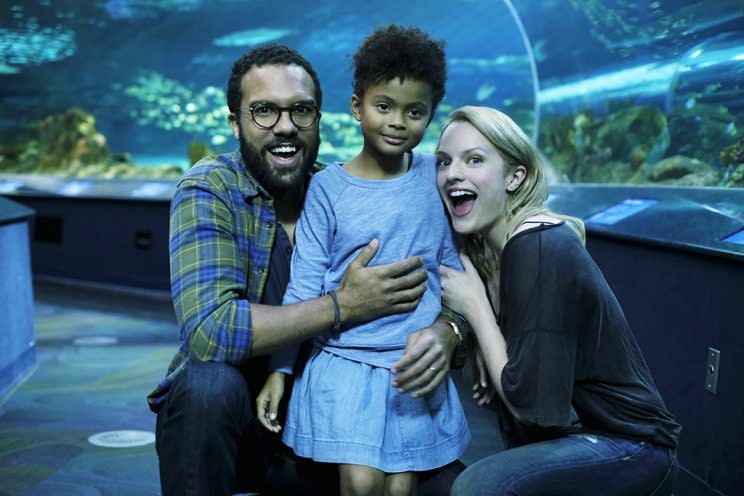‘The Handmaid’s Tale’: Margaret Atwood on the 5 Biggest Differences Between the Book and the TV Series

“It’s one of those stories that’s taken on a number of lives on its own,” remarks Margaret Atwood of her groundbreaking dystopian novel, The Handmaid’s Tale. That’s an understatement from the understated Canadian author. Since its publication in 1985, Atwood’s chilling story of one woman’s experiences in Gilead — a republic built on the ashes of the United States, where rape, misogyny, and discrimination have been legalized — has become a multimedia property, a feature film, a radio play, a stage play, an opera, and a ballet. “That’s always a compliment to a writer,” Atwood tells Yahoo TV. “Although some of the iterations are weirder than others!”
The latest incarnation of The Handmaid’s Tale is an acclaimed Hulu series that wraps up its freshman season on June 14. Overseen by showrunner Bruce Miller, with Atwood onboard as an executive producer (she also makes a cameo in the series premiere), the show is faithful to the spirit of the novel, if not always the letter. During the course of Season 1, Miller and the writers made several alterations to the novel, some subtle and others quite significant, that opened up Gilead’s universe beyond the limited point of view of the novel’s central character, Offred (played by Elisabeth Moss).

Speaking with Yahoo TV before the season began, Miller — who calls himself a “huge fan” of the book — recalled his initial nervousness about approaching the novel’s Booker Prize-winning author with his proposed changes to her story. “We talked through everything. Almost every single change, no matter how small, I talked to Margaret about. Thank God she’s been incredibly supportive and positive! But my fingernails were bitten down to the toe.” For her part, Atwood says that Miller didn’t have to work too hard to persuade her about altering Offred’s tale. “What Bruce does is that he does his thing and then sweet-talks me into agreeing with him. He’s very good at that!” Here’s Atwood’s take on five of the biggest differences between The Handmaid’s Tale as it unfolds on the page and how it unfolds onscreen.
Her Name Is June
In the novel, the heroine is given the name “Offred” by her captors at the Red Center, where fertile women are retrained to be Handmaids: breeders who are assigned to the ruling families in the hopes of bringing new babies into this fertility-challenged world. That name translates as “Of Fred,” the identity of the man whose home she lives in, and who rapes her on appointed nights every month. We are pointedly never told Offred’s pre-Gilead name. For the show, Miller made the conscious choice to give Offred a distinct identity for the flashbacks to the era before America fell and picked the name June, confirming a long-held fan theory.

Atwood says: “The readers have already decided that’s her name, and who am I to disagree with them? It wasn’t in my mind, but there wasn’t any other name in my mind either. It fits because in the first chapter, the women exchange names and all those names show up again later on except June. So by default that would have to be her name! That’s a pretty good deduction and I’ll go with that. This is June, and she really does have an identity; it’s forbidden, but it’s there. I’ve told fans before, if it works for you, go for it.”
Gilead Is a Multicultural Dystopia
When Atwood wrote The Handmaid’s Tale in the ’80s, the religious right — and America in general — was a more segregated society. Thirty years later, those racial divisions certainly haven’t gone away, but the face of the country has changed, with interracial friendships and marriages becoming more commonplace. Since the series is meant to reflect the present day, Miller made the choice to have Gilead be a more diverse society as well, welcoming other races into this republic rather than condemning them to death or exile as on the page. For example, both June’s best friend, Moira (Samira Wiley), and her husband, Luke (O-T Fagbenle), are black.

Atwood says: “In the novel, [Gilead] went for segregation. They’re not doing the show as a period piece, so if we’d done that here, it probably wouldn’t have been as plausible. When you’re creating a world, you want it to be as real as possible, and this is a more real world than a more segregated one would be. You know, the Roman Empire was extremely diverse, and that’s where Christianity grew. So segregation had absolutely everything to do with American slavery and nothing whatsoever to do with early Christianity. It’s cultural, but it’s not religious. If you’re going to go with [the idea] that Christianity means “Love your neighbor,” you can’t believe that segregation is in any way Christian. I know where they get it from — it’s an obscure passage having to do with Noah — but it’s got nothing to do with anything.”
More Moira
For much of the novel, Moira functions as a symbol for Offred rather than a physical presence. Having planned and executed a bold solo escape from the Red Center, she represents the freedom and bravery that Offred can’t herself attain. Which makes it all the more devastating when the two meet again late in the novel in the Gilead brothel, Jezebel’s, where Moira is an employee and Offred a visitor. Moira has a much bigger role in the series, with Offred assisting her in her initial escape and then reigniting her fighting spirit during their second encounter in Jezebel’s.

Atwood says: “The more we see of Samira Wiley the better! She’s very good. I just love that scene where she’s carving “Aunt Lydia Sucks” into the washroom wall at the Red Center. In the book, Offred hears about the escape, and then she runs into Moira later and gets her version of it. I think it makes dramatic sense to have more interaction [between them] in the world of Gilead. We’d feel something was missing if we were not seeing more of her.”
Luke Lives!
Offred’s last memory of her husband in the novel is a sound, rather than an image: a gunshot going off as she and her daughter flee a pursuing band of Gilead soldiers on their desperate run to the Canadian border. She’s forever condemned to imagine his ultimate fate in multiple-choice terms: (a) death, (b) imprisonment, or (c) maybe, just maybe, escape. Miller chooses option C for the series, devoting the seventh hour to Luke’s journey north into a refugee zone in Canada known colloquially as “Little America.”

Atwood says: “In the book, she doesn’t know whether he’s dead or alive. So there is an opening for him to be alive! Any opening that’s there [in the book], the writers have basically taken advantage of. It’s a whole team of writers and they’re so into it. I’m all for them!”
There’s more to this Tale
The novel ends with Offred’s own fate a mystery, even to the citizens of the far future society that appear in the book’s controversial epilogue. But there’s more, much more, to come for her in the series, which will continue her story into a second season, for which there’s less of a road map.

Atwood says: “It’s absolutely interesting that it will be an ongoing series. We recorded an audiobook for Audible in which we added a Q&A with Professor James Darcy Pieixoto [the narrator of the epilogue] about his research, and one of the questions we ask him is: ‘Do you have any other research?’ And he says, ‘Actually, we have discovered some documents, and I can’t tell you about them until we authenticate them.’ That’s [another opening] for Bruce.”
The Handmaid’s Tale releases new episodes Wednesdays on Hulu.
Read more from Yahoo TV:


